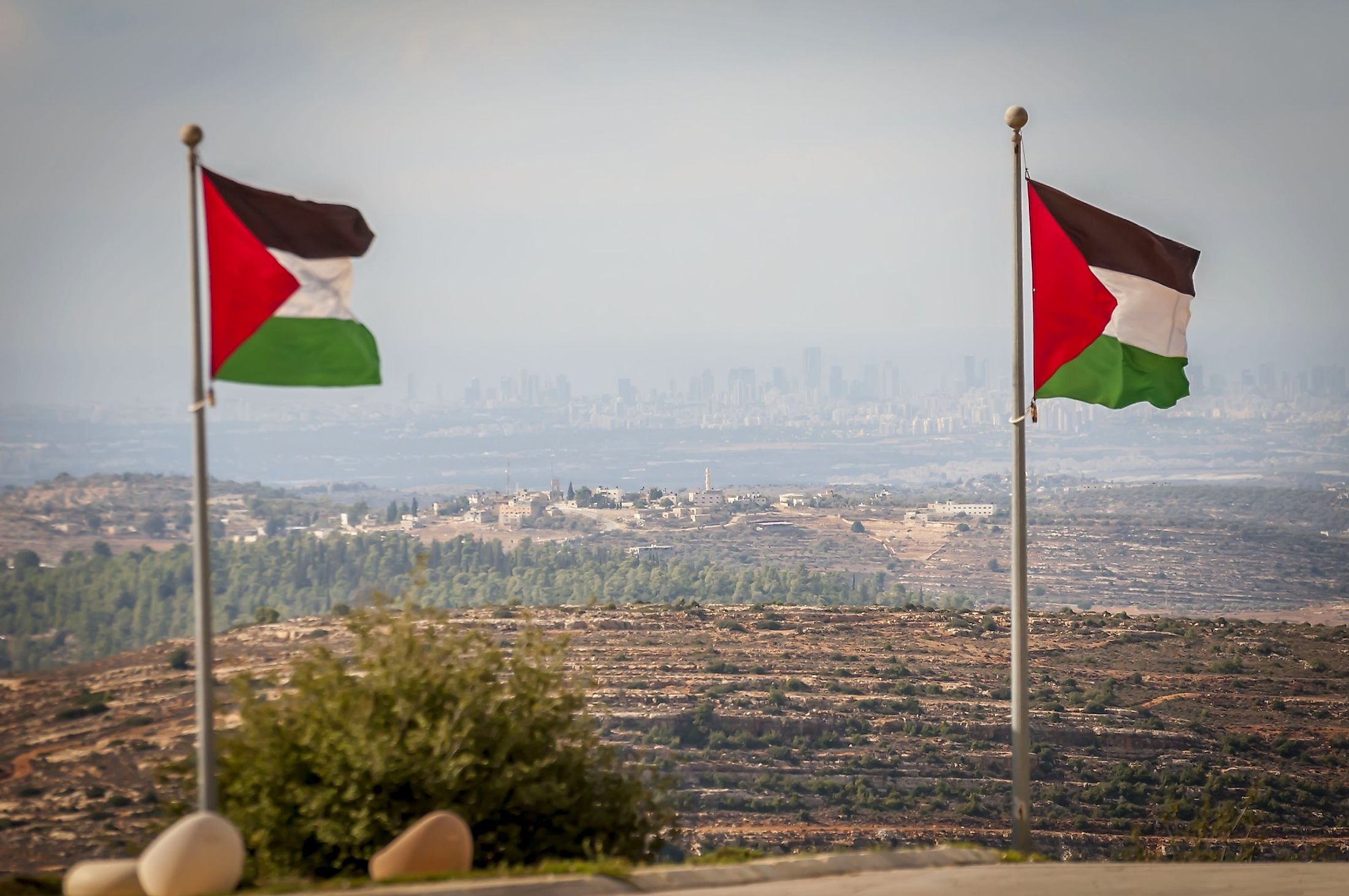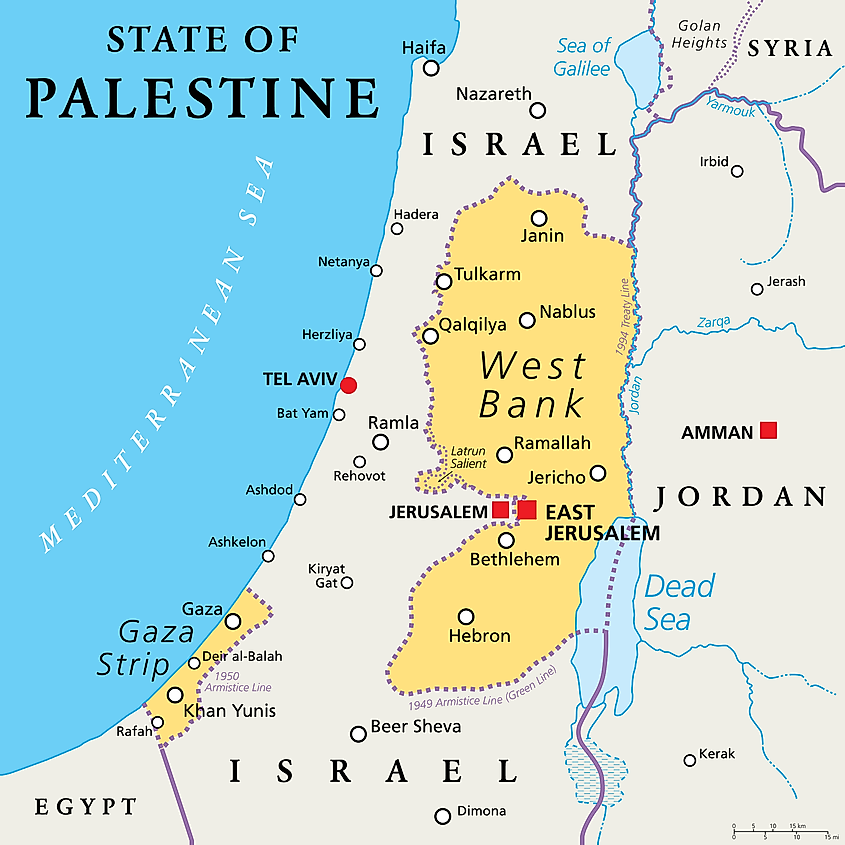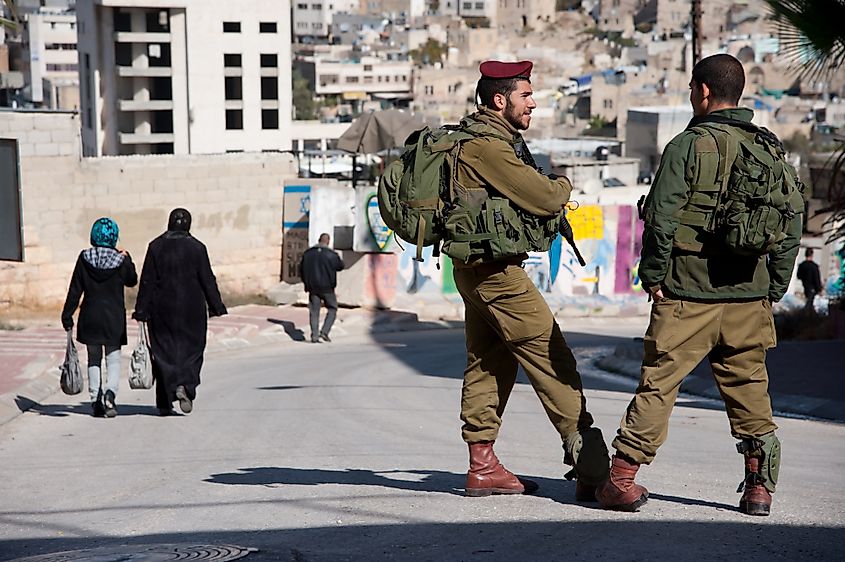
West Bank
As its name implies, the West Bank is a territory situated on the western bank of the Jordan River. Many countries recognize it as being part of the so-called State of Palestine, but Palestine’s borders are yet to be determined, pending a resolution to the Israeli-Palestinian conflict. For both Israelis and Palestinians, the West Bank forms the heart of the Biblical Holy Land. It contains several important religious sites that are holy to Jews, Christians, and Muslims. The West Bank is also home to most of the Palestinian population, and the headquarters of the Palestinian Authority (PA).

Geography And Demographics
The West Bank has a total land area of 6,220 sq. km. This includes part of the holy city of Jerusalem, known as East Jerusalem. It is bordered by the Hashemite Kingdom of Jordan to the east, and by Israel in all other directions. The name “West Bank” was a term first used by the Jordanians when they annexed the territory in 1949, following the first Arab-Israeli war. Many Israelis refer to it as Judea (Hebrew: Yehuda) and Samaria (Hebrew; Shomron), denoting the fact that it was the territory in which the Biblical kingdoms of Judah and Israel (also called Shomron) were situated. Much of the West Bank’s territory consists of north-south oriented limestone hills. These hills are divided between the Samarian Hills north of Jerusalem, and the Judean Hills in the south. The hills slope down into the Jordan Valley and the area adjacent to the Dead Sea, which is the lowest place on Earth.
More than 3.2 million people live in the West Bank. This includes residents of East Jerusalem. Most of the people residing in the West Bank are Palestinians, but there are also hundreds of thousands of Israelis who have come to live in communities built by the Jewish state after the 1967 war. Palestinian refugees and their descendants make up around 30% of the West Bank’s population. East Jerusalem is the most populous city in the territory. The city is heavily-contested by Israelis and Palestinians. Israelis see it as part of their unified capital of Jerusalem, while Palestinians want it as the capital of a future Palestinian state. Other major cities in the West Bank include Hebron, Bethlehem, Nablus, Jericho, Tulkarm, and Ramallah, which serves as the headquarters of the PA.
History

The West Bank was formed in the aftermath of the first Arab-Israeli war in 1948. When Israel declared its independence, the armies of several Arab states invaded the territory of the former British Mandate of Palestine, hoping to destroy the nascent Jewish state. By 1949, however, the Israelis had successfully repelled the Arab invasion, though they did not gain control of all of former mandate Palestine. Egypt remained in control of a narrow strip of territory along the Mediterranean Sea that became known as the Gaza Strip, while Transjordan controlled a large territory on the western side of the Jordan River, including the eastern section of Jerusalem. After the war ended, Transjordan formally annexed this territory, referring to it as the “West Bank”. It also bestowed citizenship on all the residents therein.
The West Bank would remain under Jordanian control for 19 years. In 1967, however, the map of the Middle East would fundamentally change. Expecting an attack by its Arab neighbors, Israel launched pre-emptive strikes on Egypt and Syria. For its part, Jordan’s King Hussein I was initially reluctant to enter the war, but did so anyways, under foreign and domestic pressure. Thus, Jordanian forces opened fire on Israel in Jerusalem. Jordan’s decision to enter the war proved catastrophic as the country would end up losing the entire West Bank. The so-called Six Day War left Israel in control of the West Bank, the Gaza Strip, and the Sinai Peninsula.
Shortly after the 1967 war, Israelis began settling in areas of the West Bank. Over the course of several decades, Israel has built many new villages, towns, and cities in the disputed territory. Israel has always maintained that Jews have the right to live in the West Bank as it is the Biblical homeland of the Jewish people. But the local Palestinian population has always resented growing Israeli encroachment on what they believe is their land. Tensions between Israel and the Palestinians boiled over in 1987, when the first Palestinian Intifada (uprising) took place. This uprising lasted until 1993, when Israeli and Palestinian officials negotiated a deal that allowed Palestinians limited self-rule in the Gaza Strip and the West Bank city of Jericho. This arrangement was part of the Oslo Accord, signed in September 1993. The agreement allowed for the setting up of an autonomous Palestinian government, known as the Palestinian National Authority, or simply Palestinian Authority (PA).
In the years that followed the Oslo Accord, Israel allowed the PA to take control of other large Palestinian cities, as well as some rural areas of the West Bank. From this time forward the West Bank was divided into three zones: Area A, where the PA has full control, Area B, where the PA controls civil affairs and Israel maintains security control, and Area C, which remains under full Israeli control. In the latter part of the 1990s, however, the peace process stalled. In 2000, the Palestinians launched a second Intifada, which turned out to be a lot more deadly for both them and the Israelis than the first.
The West Bank Today

Israeli soldiers patrol among Palestinian pedestrians in Hebron, West Bank. Editorial credit: Ryan Rodrick Beiler / Shutterstock.com
The status of the West Bank remains in contention. Many Israelis want their government to formally annex parts of the territory, while Palestinians remain adamant that the entire West Bank, including East Jerusalem, be part of a future Palestinian state. Since the beginning of the 21st century, several attempts have been made to revive the peace process, but without any success. Meanwhile, the Palestinians are growing frustrated with their own leaders. Presidential and parliamentary elections in PA-ruled territory have not been held for 15 years. During this time, the economic and living conditions of ordinary Palestinians in the West Bank have worsened. The PA itself is struggling with corruption and financial difficulties. Some fear it could eventually collapse altogether, leaving Israel responsible for the entire West Bank once again.











